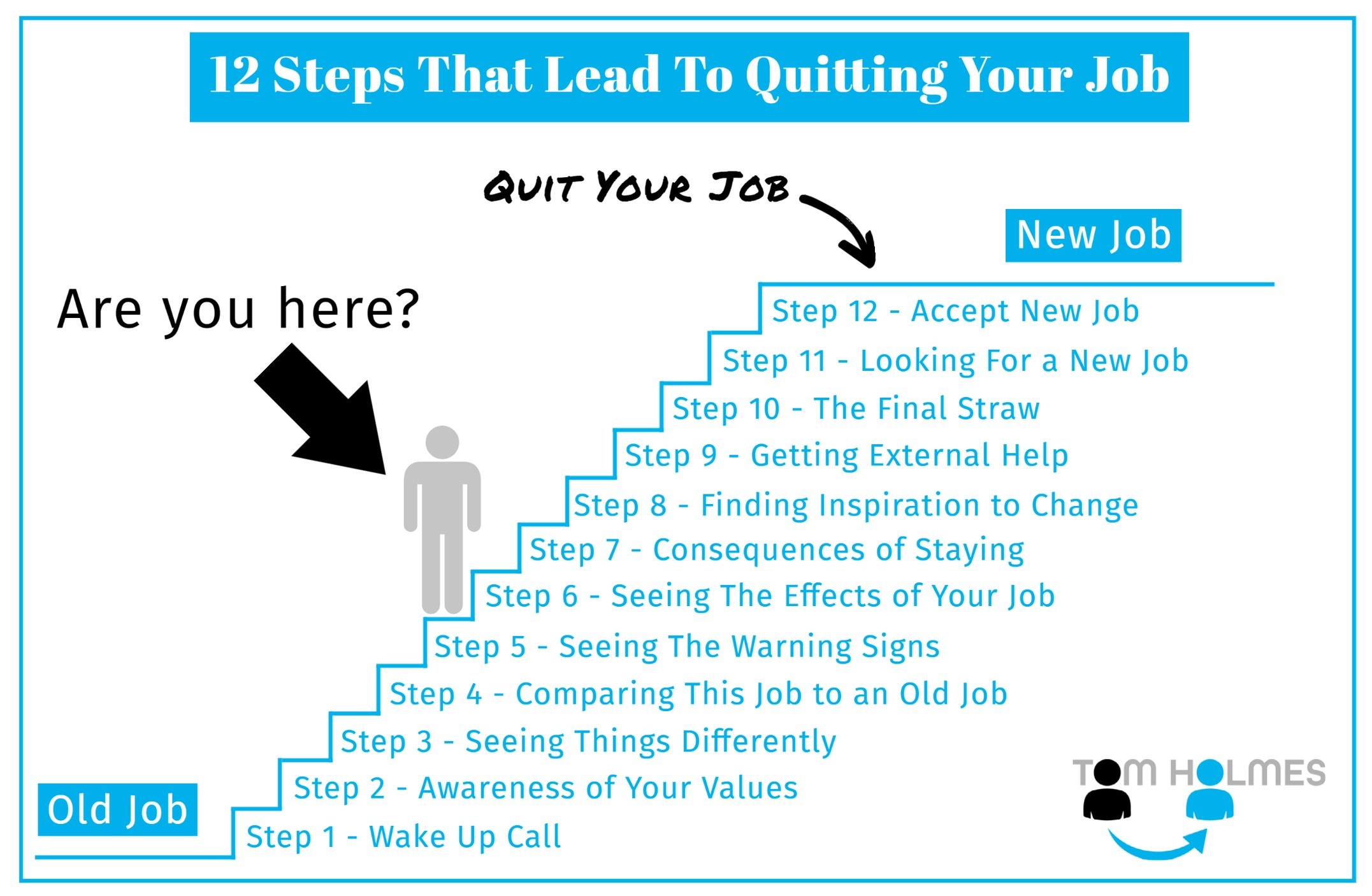12 Steps That Lead To Quitting Your Job
Unhappy at work?
Thinking about changing jobs?
You’re likely at one of these steps.
3 minute read
Step 1 - A Wake Up Call
You may have been going along fine in your job, until one day an experience at work jolts your perspective.
This experience could have been:
A company restructure
A company decision
Being blamed for something
A lack of support
Something you were made to do
Colleagues unfairly sacked
Change in job role
Move offices or departments
Put on a project that is uninspiring
Overlooked for a promotion
Key figures leave
The experience may have triggered an uneasy feeling in your gut. “Something is happening here” you say to yourself - something you didn’t see coming.
Its a wake up call that gets the cogs turning.
Step 2 - Awareness of Your Morals and Values
The wake up call lights up your morals and values. You now see things you didn’t see before. You start to question:
“I didn’t see that side of them before.”
“I don’t like the way they’ve gone about this restructure.”
“I didn’t think my company would treat people like that.”
“I can’t believe they pointed the finger at me.”
But, at this step, you try to think of it as a one off and put it out of your mind.
Step 3 - Seeing Things Differently
Because of this new awareness you and the company you work for start to see things differently.
“It’s like it’s their way vs my way.”
“They’ve got different morals or values to me.”
“They do things differently to how I would do it.”
“We don’t see eye to eye.”
But, at this step you hope it’s just a phase and that things will get better.
Step 4 - Comparing This Job to an Old Job
You question “why are they doing this like this?” So you may begin to compare your current job to an old job.
You might say:
“My old boss wasn’t like this.”
“This company is not the same as my last company.”
“My last company treated people much better than this.”
Step 5 - Seeing The Warning Signs
The step 1 wake up calls repeat.
“Jane on the front desk has gone.”
“They’ve got a real blame game culture.”
You talk to colleagues to see if they see the warning signs.
“Oh my god, can you believe they did that?”
You talk to partners, friends or family about the warning signs.
“I said this… then she said that…”
You’re seeing the warning signs. But, still don’t quite believe what your seeing.
Step 6 - Seeing The Effects of Your Job
You begin to see the effects of your job on yourself and the people around you.
“I’m unhappy at work - I’m burnt out, stressed and unhealthy.”
“I’m not being a good husband.”
“I’m taking my work home with me.”
“I don’t get any time with my kids.”
You can’t deny the reality anymore. Hope that the situation will improve is fading.
Step 7 - Looking at The Consequences of Staying
You look at the consequences of staying where you are.
“I won’t make it.”
“My wife will leave me.”
“My kids will grow up without a dad.”
You may look around the office at your colleagues to see what you will end up like if you stay.
“I don’t want to end up like my boss.”
The pain of staying begins to outweigh the pain of change.
Step 8 - Finding Inspiration to Change
You talk to someone who’s made the leap that you want to make.
“My mate made the jump and he’s a lot happier”
“She’s got more support at her new company.”
“They’ve got much better work/life balance where she works now.”
You realise that change is doable. “Why do this, when I can do that?”
Step 9 - Getting External Help
You may seek out a professional coach, mentor, counsellor or psychologist.
They help with validating your current situation, discussing options and helping you with an exit strategy.
With their help you feel more confident that ‘someones got your back.’
Step 10 - The Final Straw
You may have a final wake up call.
And you say to yourself ‘that’s the final straw’ - the final nail in the coffin.
“My boss said this… and that was enough for me.”
“This is not going to change. I’m leaving.”
“I deserve to be happy.”
Step 11 - Looking For a New Job
Looking for a new job is usually about finding a new job before leaving this job.
You get the ball rolling by looking at seek, talking to recruiters, talking to your networks, applying for jobs or going for interviews.
Determination to change is building.
You start thinking about your exit conversation - what you will say and how you will say it.
Step 12 - Accept The New Job
People are knocking at your door or job offers are on the table.
You pick a job offer that lights you up and make the call or sign the contract and accept the new offer.
Quitting Your Job
You have the exit conversation and hand in your resignation letter.
You do your notice period then walk out the door.















